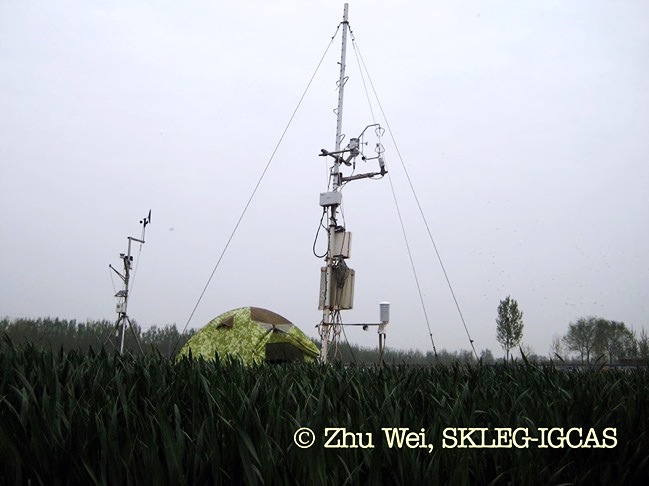 |
| Figure. SKLEG-IGCAS Hg0- micrometeorological – flux enclosure system has went through comprehensive field-testing and flux monitoring trials before all-seasonal measurements started over a North China Plain cropland in 2011. (Image by ZHU Wei) |
In the rather chemical inert elemental form, mercury (Hg) has extraordinary volatility among the heavy metals. Atmospheric transport of Hg0 associated with a generally slow oxidation allows Hg to be (dry or wet) deposited in areas very far (hemispherical scale) from where it was originally emitted to the atmosphere. Therefore, Hg is considered a global pollutant.
This year over 130 countries including China agreed to the UN’s Minimata Convention for reducing the emission and use of mercury (Hg). Important as this treaty is, it will neither roll back the toxic legacy of past Hg emissions nor end the exposure of millions of people to harmful levels of this potent neurotoxin. The legacy of past deposition, continued emissions and use means that Hg remains a challenge for many countries. Meeting the challenge has far-reaching implications for how we manage the landscape to produce food, fish and forest products.
While human activities perturb global Hg cycling by altering atmospheric Hg budget through emissions of a mixture of mercury species, natural emissions release predominantly Hg0. According to a recent estimate, natural emissions account for nearly two-thirds of global Hg input into the atmosphere. However, these estimates remain highly uncertain because of the limitations in the measurement approaches and scale-up calculations. To better understand the biogeochemical cycling of mercury, it is important to quantify the air-surface exchange of Hg0. This can be achieved by a number of field techniques including enclosure methods, optical long-path spectroscopic methods, micrometeorological methods and bulk methods.
In the recently published critical review, an 82-page contribution to the renowned CRES&T journal, the researchers from the FENG Xinbin group at Institute of Geochemistry, CAS (IGCAS) and their co-author focus on theory, applications, strengths and limitations of the various experimental methodologies applied to gauge the natural flux process. They present an in-depth review including more than 260 references, a comprehensive literature synthesis and methodological and instrumentation advances for terrestrial and marine Hg flux studies in recent years. In particular, the researchers outline the theory of a wide range of measurement techniques and detail the operational protocols.
In the FENG Xinbin group at the State Key Laboratory of Environmental Geochemistry (SKLEG) of IGCAS, they have in recent and on-going field experiments (2009-) studied Hg0 fluxes over canopies (agricultural crops, forests etc.) by using flow-through enclosure as well as micro-meteorological techniques coupled with automatized Hg0 vapour analyzers (example shown in Figure below). The CRES&T paper is a companion paper of:
1) Lin, C.-J.; Zhu, W.; Li, X.; Feng, X.; Sommar, J.; Shang, L., Novel Dynamic Flux Chamber for Measuring Air-Surface Exchange of Hgo from Soils. Environ. Sci. Technol. 2012, 46, (16), 8910-8920.
2) Zhu, W.; Sommar, J.; Li, Z.; Feng, X.; Lin, C. J.; Li, G., Highly elevated emission of mercury vapor due to the spontaneous combustion of refuse in a landfill. Atmospheric Environment 2013, 79, 540-545.
3) Sommar, J.; Zhu, W.; Shang, L.; Feng, X.; Lin, C.-J., A whole-air relaxed eddy accumulation (REA) measurement system for sampling vertical vapour exchange of elemental mercury. Tellus B 2013, Accepted, In press.
(By Jonas Sommar)